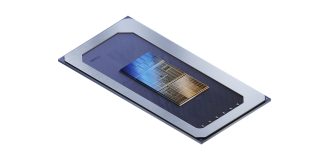If you use the internet on the move, then Intel has a neat, 3-letter acronym lined up ready for you. MID. It stands for Mobile Internet Device. The latest version seems to be generating interest among the bit-part smartphone players at CES. KitGuru tunes into the available wireless using a non-Intel Blackberry and listens to the chatter.
When Anand Chandrasekher, Intel Corporation senior vice president and head honcho for the Ultra Mobility Group, gave his keynote at Computex 2009, he was predicting that his Medield platform would be going big-bananas in 2011. He actually called the mini-speech “The Art of the Possible”. OK, so he was a little out on timing, but the time has come and Intel is preparing for a huge push on the mobile front. Is it possible for the world's chip leader to sell any chips into smartphones?
First, quick history lesson so we're all talking the same Intel-non-ARM-lingo.
At the Intel Development Forum in Beijing 2007, Intel announced the McCaslin platform which combined a 90nm pre-Atom chip – based on part of the Intel Pentium M called the A100 and A110.
Menlow followed quickly in 2008 with the Intel Atom processor, made at just 45nm.
By 2009, Moorestown moved the market forward for Intel and it's been holding the fort down for a long time.
Now Intel's fourth generation effort, Medfield, brings the Atom processor down to 32nm.
This new attack is specifically aimed at ARM, in an attempt to dislodge the (deliberately) lightweight chip from the market. Intel has managed to forge good relations with Apple in the past, so the question has to be “Will Intel be able to get inside future iPhones or Blackberries with this set up?”.
Probably the most realistic quote, from inside Intel, happened when Mike Bell said “Battery life on this platform is not the best in the mobile market, but it is by far not the worst”. Not the worst. Hmm. OK. At least the General Manager of Intel's Ultra Mobility Group was being honest.
Right now, Intel's approach to apps that have been specifically written for ARM chips is to run some sort of internal emulation. This is likely to be painfully slow. “They will run quicker if you recompile for Intel chips”, chirped Mike. Nice.

KitGuru says: Intel is closer, but not there yet. LG said it would go with Intel technology over a year ago, but the phone was never produced. We can only imagine the frustration levels inside Intel right now. It must be ‘somewhere north of annoying' to be sitting on the sidelines while entire new markets of processors are being developed. That said, KitGuru's money is still on Intel pulling a rabbit out of its hat in the next couple of years. Just not now.
Comments below or in the KitGuru forums.
 KitGuru KitGuru.net – Tech News | Hardware News | Hardware Reviews | IOS | Mobile | Gaming | Graphics Cards
KitGuru KitGuru.net – Tech News | Hardware News | Hardware Reviews | IOS | Mobile | Gaming | Graphics Cards



2 comments
Pingback: Will Intel’s new Atom bomb or do really well? | KitGuru
Pingback: Lenovo launches Intel-powered smartphone in May | KitGuru